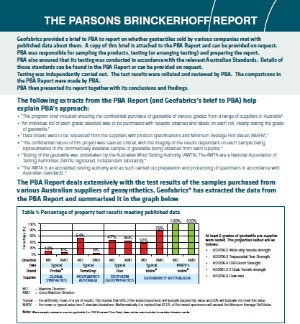 Two years ago, Geofabrics® engaged a leading consulting firm, Parsons Brinckerhoff Australia (PBA), to test a range of geotextiles sold by various companies in Australia and to report independently on whether those geotextiles met with the published specifications about them.
Two years ago, Geofabrics® engaged a leading consulting firm, Parsons Brinckerhoff Australia (PBA), to test a range of geotextiles sold by various companies in Australia and to report independently on whether those geotextiles met with the published specifications about them.
The independent testing samples involved at least six grades of geotextiles per supplier. Properties tested included AS3706.2 (Wide strip tensile strength), AS3706.3 (Trapezoidal Tear Strength), AS3706.4 (CBR Burst Strength), AS2001.2.2 (Grab Tensile Strength), and AS3706.9 (Flow Rate).
The variations between the published data and the actual data was intriguing. The published "typical" values (an arithmetic mean) showed considerable fluctuations among all manufacturers. Measured by Minimum Average Roll Values (MARV), however, Geofabrics Australasia wound up with a 100% mark for matching or exceeding its own published data.
The independent report revealed that some samples tested as much as 75% below the published data (again, through a "typical" data measurement). It also revealed that in some instances, it was very difficult to interpret the readily available data sheets, as key information such as whether data pertained to transverse and longitudinal test directions were not indicated. This could create confusion for design engineers in the geotextile selection process. As not all geotextiles perform the same in both directions, performance in application could be affected.
Download the Geofabrics® April 2011 Journal to read an overview of the Parsons Brinckerhoff with additional commentary on key issues.
Visit Geofabrics website at www.geofabrics.com.au.
Chris Kelsey is the editor of Geosynthetica, chris@geosynthetica.net.











